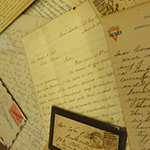 University Library
Sources of Inquiry
University Library
Sources of Inquiry
 University Library
Sources of Inquiry
University Library
Sources of Inquiry
Financial records can take many forms, but typically consist of print and electronic records representing monetary and financial transactions. They can include account balance sheets, income statements, cash flow documents, receipts, payroll ledgers, bills of sale, payment orders, invoices, and more. Taken together, these records provide information about the financial position, status, or condition of a person or organization.
We study financial documents because they can reveal difficult-to-find information about past currency systems, regional and international economies, and the sources of financial support for organizations. They can even provide evidence of geographically shifting populations, the changing social status of individuals and groups, and the status of civil and individual rights for whole swaths of the population.
Financial records dating from 1784-1970 are on display. The oldest is a receipt for the £74 sale of Sarah, a 25-year-old slave in New York state. It dates from one year after the conclusion of the Revolutionary War, when the United States lacked a national mint and relied on foreign currency in its domestic economy. Also on display are a payment order for slave labor issued by the US military a few months before the War of 1812's Battle of New Orleans, an asset and liability summary for a Los Angeles-based construction company in the early 20th century, and an insurance invoice for coverage of damage to personal property resulting from enemy attack during World War II. From the postwar period are a ledger showing the payroll for migrant farm workers at the Mulholland Orchard Company in 1952, a balance sheet from the Emergency Committee to Aid Farm Workers from 1961, and more.
Case 5, Journals and Diaries, is a wide tower towards the center of the gallery.
1
Sales of Land and Negroes of James W. Cook, December 7, 1858Legal and Financial Documents on Slaves and Slavery in the United States Collection
2
Order to pay Alex Choppin for his slave Frédérick's labor digging the sewage canal behind Fort St. Ferdinand in New Orleans, September 3, 1814Legal and Financial Documents on Slaves and Slavery in the United States Collection
3
Bill of sale for "a Negro Wench named Sarah Aged about 25 years," sold to Henry Remsen, Merchant of New York, November 5, 1784Legal and Financial Documents on Slaves and Slavery in the United States Collection
4
Assets and Liabilities for Moore & Burlingame Building Construction Company, August 1, 1914George and Cecilia Burlingame Papers
5
Insurance invoice paid by George E. Burlingame covering damage to property in the mainland US caused by enemy attack during World War II, July 1, 1942George and Cecilia Burlingame Papers
6
Balance sheet for the Emergency Committee to Aid Farm Workers, May 11, 1961Max Mont Collection
7
Payroll Ledger from the Mulholland Orchard Company, August 1-15, 1952Catherine Mulholland Collection
8
Financial Report for Hillel Council of Jewish Students, University of California at Los Angeles Chapter, March 1945Jewish Federation Council of Greater Los Angeles, Community Relations Committee Collection, Part 2
9
Financial Ledger from Zero Population Growth of Los Angeles, Inc., 1969-70Zero Population Growth of Los Angeles, Inc. Collection
